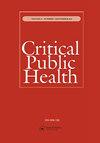Vulnerability and antimicrobial resistance
IF 2.3
3区 医学
Q2 PUBLIC, ENVIRONMENTAL & OCCUPATIONAL HEALTH
引用次数: 5
Abstract
ABSTRACT It is now well-recognised that antimicrobial resistance (AMR), or the ability of organisms to resist currently available antibiotics and other antimicrobial drugs, represents one of the greatest dangers to human health in the 21st Century. As of 2022, AMR is a top-10 global public health threat. Various national and transnational initiatives have been implemented to address accelerating AMR, and the pressure to find local and global solutions is increasing. Despite this urgency, surprisingly limited progress is being made in rolling back or even slowing resistance. A multitude of perspectives exist regarding why this is the case. Key concerns include an enduring dependency on market-driven drug development, the lacklustre governance and habitual over-prescribing of remaining antimicrobial resources, and rampant short-termism across societies. While rarely presented in such terms, these disparate issues all speak to the social production of vulnerability. Yet vulnerability is rarely discussed in the AMR literature, except in terms of ‘disproportionate effects’ of AMR. In this paper, we offer a reconceptualisation of vulnerability as manifest in the AMR scene, showing that vulnerability is both a predictable consequence of AMR and, critically, productive of AMR to begin with. We underline why comprehending vulnerability as embodied, assembled, multivalent and reproduced through surveillance matters for international efforts to combat resistance.易感性和抗菌素耐药性
摘要:众所周知,抗菌素耐药性(antimicrobial resistance, AMR),即生物体对现有抗生素和其他抗微生物药物的耐药性,是21世纪人类健康面临的最大威胁之一。截至2022年,抗生素耐药性是全球十大公共卫生威胁之一。已经实施了各种国家和跨国倡议,以解决加速的抗生素耐药性问题,寻找地方和全球解决方案的压力正在增加。尽管如此紧迫,但在减少甚至减缓耐药性方面取得的进展却令人惊讶地有限。关于为什么会出现这种情况,存在多种观点。主要问题包括长期依赖市场驱动的药物开发、治理不力和习惯性过度使用剩余的抗微生物药物资源,以及整个社会普遍存在的短期主义。虽然很少以这种方式提出,但这些不同的问题都说明了脆弱性的社会生产。然而,除了AMR的“不成比例的影响”之外,在AMR文献中很少讨论脆弱性。在本文中,我们提供了脆弱性的重新概念化,在AMR场景中表现出来,表明脆弱性既是AMR的可预测结果,而且至关重要的是,从一开始就产生了AMR。我们强调为什么理解脆弱性是具体的、聚集的、多重的和通过监测再现的,这对国际上抗击耐药性的努力至关重要。
本文章由计算机程序翻译,如有差异,请以英文原文为准。
求助全文
约1分钟内获得全文
求助全文
来源期刊

Critical Public Health
Multiple-
CiteScore
5.90
自引率
7.10%
发文量
36
期刊介绍:
Critical Public Health (CPH) is a respected peer-review journal for researchers and practitioners working in public health, health promotion and related fields. It brings together international scholarship to provide critical analyses of theory and practice, reviews of literature and explorations of new ways of working. The journal publishes high quality work that is open and critical in perspective and which reports on current research and debates in the field. CPH encourages an interdisciplinary focus and features innovative analyses. It is committed to exploring and debating issues of equity and social justice; in particular, issues of sexism, racism and other forms of oppression.
 求助内容:
求助内容: 应助结果提醒方式:
应助结果提醒方式:


